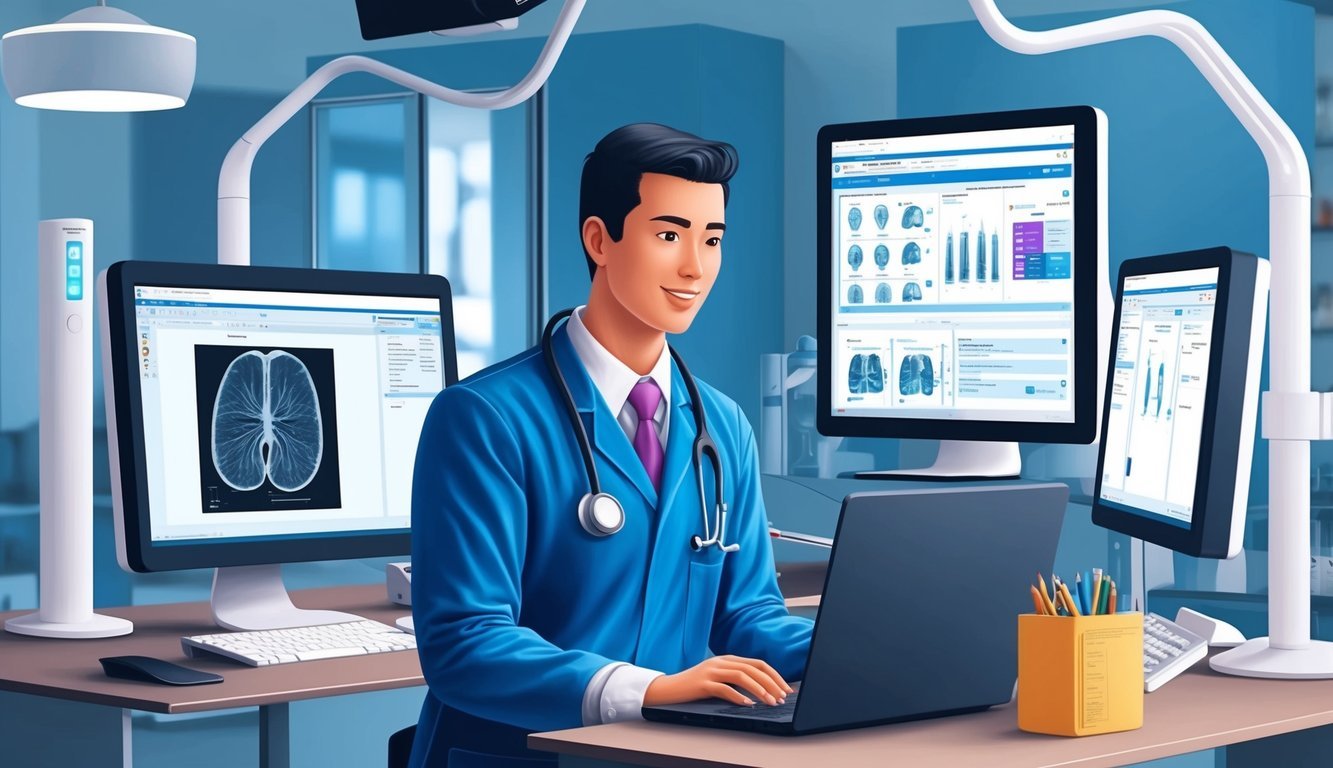As you consider advancing your career in the healthcare field, enrolling in a radiology tech school online can be a strategic move.
Online radiology tech programs offer flexibility and convenience, making it easier for you to balance work, studies, and personal commitments.
Radiologic sciences encompass a range of diagnostic imaging techniques essential for patient care.
Many accredited online programs provide comprehensive curricula that cover crucial areas such as anatomy, patient care, and imaging technology.
By participating in these programs, you will prepare yourself for entry-level positions in a rapidly growing industry, characterized by a high demand for professionals.
When researching your options, it’s essential to compare different schools and programs to find one that meets your educational and career goals.
Look for features such as accreditation, course offerings, and financial aid opportunities, as these factors can significantly impact your journey to becoming a radiologic technologist.
Exploration of Online Radiologic Technologist Programs
Online radiologic technologist programs offer various pathways to pursue a career in this essential healthcare field.
Understanding accreditation, degree types, and core curriculum helps in selecting the right program for your goals.
Accreditation and Certification
When choosing an online radiology tech program, make sure it is accredited by a recognized body like the Joint Review Committee on Education in Radiologic Technology (JRCERT).
Accreditation verifies that the program meets industry standards for education and training.
To practice as a radiologic technologist, you must also obtain ARRT certification.
This certification requires passing an exam that evaluates your knowledge and skills.
Being certified can enhance job prospects, as many employers prefer or require it.
Degree Types and Educational Paths
You can pursue several educational paths in radiologic technology, each designed for different career goals and entry points. Degree options include:
| Degree Type | Description |
|---|---|
| Associate Degree | Typically a two-year program, focusing on foundational skills. Suitable for entry-level positions. |
| Bachelor’s Degree | A four-year program providing advanced knowledge and skills, opening up more career opportunities. |
| Degree Completion Program | Tailored for individuals with prior education in healthcare who want to earn a bachelor’s degree. |
Selecting the appropriate degree will depend on your current qualifications and career aspirations.
Core Curriculum and Clinical Experience
The core curriculum in radiologic technology encompasses both theoretical knowledge and practical skills.
Key subjects often include:
- Anatomy and Physiology
- Radiographic Procedures
- Patient Care and Safety
- Imaging Technology and Techniques
In addition to coursework, clinical experience is crucial.
Many online programs integrate clinical components in local healthcare facilities, ensuring that you meet the necessary hands-on training requirements.
This experience prepares you for real-world scenarios and is often required for certification.
Technical Skills and Specializations in Radiology

Radiology technology encompasses a range of technical skills and specializations vital for effective patient care and accurate imaging.
Understanding these components will enhance your proficiency and career opportunities in the field.
Imaging Techniques and Technologies
You will work with various imaging modalities that are critical in diagnostic processes.
Each technique has specific applications and requires distinct skills:
| Imaging Technique | Description |
|---|---|
| Computed Tomography (CT) | Combines X-ray images taken from different angles to create cross-sectional images of bones and soft tissues. |
| Magnetic Resonance Imaging (MRI) | Utilizes powerful magnets and radio waves to generate detailed images of organs and tissues. |
| Sonography | Employs sound waves to visualize internal organs, useful for monitoring pregnancies and assessing organ function. |
| Mammography | A specialized X-ray for breast imaging, essential in early detection of breast cancer. |
| Fluoroscopy | Provides real-time imaging of movement within the body, commonly used in guiding interventions. |
Familiarity with these technologies and their specific applications will enrich your expertise and improve patient outcomes.
Advanced Imaging and Sectional Anatomy
In addition to basic imaging skills, you need a comprehensive grasp of advanced techniques and anatomy.
Understanding sectional anatomy is crucial.
This includes:
- CT and MRI sectional images — Knowing how to interpret cross-sectional images helps in identifying pathologies.
- Nuclear Medicine — Familiarity with radioactive materials for imaging and treatment requires knowledge of safe handling and patient care.
- Radiation Therapy — Understanding dosimetry and treatment planning is essential for effective patient management.
The ability to integrate knowledge across these modalities enhances your diagnostic capabilities and ensures timely, accurate interventions.
Patient Care and Safety Considerations
Patient care is paramount in radiology.
Your role involves ensuring patient safety through:
- Informed Consent: Clearly explaining procedures and potential risks before imaging.
- Radiation Safety: Applying principles of ALARA (As Low As Reasonably Achievable) to minimize exposure.
- Vascular/Interventional Procedures: Competence in these areas includes understanding sterile techniques and managing complications.
Incorporating these patient-centered practices not only improves outcomes but also builds trust and comfort.
You can learn more about these practices through resources such as the American Registry of Radiologic Technologists (ARRT) for ongoing education and guidelines.
Career Development for Radiologic Technologists

The career path for radiologic technologists is promising, offering various opportunities for growth and advancement.
Understanding the job market, exploring advancement options, and engaging in networking and continuing education are essential for success in this field.
Job Market Analysis
The job market for radiologic technologists is strong and continues to grow.
According to the U.S. Bureau of Labor Statistics, employment in this field is projected to increase by approximately 7% through 2031.
This growth stems from an aging population and the increased need for diagnostic imaging.
Key factors influencing job availability include:
| Factor | Impact |
|---|---|
| Technological advancements | Create new roles |
| Aging population | Increases demand for healthcare services |
| Health policy changes | Affect funding and service delivery |
Radiologic technologists can find opportunities in hospitals, clinics, and diagnostic imaging centers.
Additionally, remote work options are becoming more common in tele-radiology, expanding job prospects.
Career Advancement Opportunities
Once you establish your career as a radiologic technologist, various paths for advancement are available.
By pursuing further education or obtaining specialized certifications, you can enhance your skills and increase your earning potential.
Some popular advancement options include:
- Radiation Therapist: Focus on treating cancer patients using radiologic technology.
- MRI Technologist: Specialize in magnetic resonance imaging.
- Radiologic Technology Instructor: Teach the next generation of technologists.
You can also move into administrative roles, such as radiology supervisor or department manager, by gaining experience and leadership skills.
Advanced degrees, such as a bachelor’s or master’s in health administration, can facilitate this transition.
Networking and Continuing Education
Networking and ongoing education are crucial for your development as a radiologic technologist.
Joining professional organizations, such as the American Registry of Radiologic Technologists (ARRT) or the American Society of Radiologic Technologists (ASRT), provides access to valuable resources.
Continuing education can take various forms, including:
- Workshops and conferences: Stay updated on the latest technology and practices.
- Online courses: Earn additional certifications that can enhance your qualifications.
Participating in seminars and local networking events can also help you build relationships with peers and industry leaders.
These connections can lead to mentorship opportunities and job referrals.
Understanding the Clinical and Professional Requirements
In pursuing a career as a radiologic technologist, you need to meet specific clinical and professional standards.
These requirements focus on gaining hands-on experience and developing essential skills for patient care and communication.
Clinical Experience and Hands-On Training
Clinical experience is a vital component of your training in radiology tech programs.
Most accredited programs mandate a minimum number of clinical hours where you will engage in practical, supervised experiences.
These hours provide exposure to various imaging techniques and patient scenarios.
You’ll learn to operate complex machines and ensure patient safety during diagnostic procedures.
Typically, clinical training involves:
- Direct patient interaction
- Adherence to safety protocols
- Collaboration with healthcare professionals
This experience is crucial for becoming a registered radiologic technologist.
Effective hands-on training prepares you to handle real-world challenges in busy medical environments.
Consider programs like the one offered by Doña Ana Community College for an integrated approach to learning.
Ethical and Communication Skills
Developing ethical standards and communication skills is equally important in your training.
As a radiologic technologist, you will frequently interact with patients and colleagues.
Strong communication skills enhance your ability to gather medical histories and explain procedures clearly.
You must also understand ethical considerations in patient care, such as:
- Maintaining patient confidentiality
- Informed consent
- Respecting cultural differences
Effective critical thinking skills will help you respond to varying patient needs while promoting a safe environment.
Continuous training in ethical practices ensures you uphold the standards required in the healthcare industry.
Programs often integrate these skills into the curriculum to prepare you for challenges in the field.
Selecting the Right Online Radiologic Technology Program

Choosing an online radiologic technology program requires careful consideration of various features, financial implications, and institutional reputation.
Your decision will be influenced by how well these factors align with your career goals and personal circumstances.
Evaluating Online Program Features
When assessing online radiology tech programs, prioritize the curriculum, course delivery format, and clinical experience opportunities.
Look for programs that are accredited, such as the one offered by the University of Louisiana at Monroe, which allows students to transfer credits based on prior certification.
Make sure the program offers a mix of theoretical knowledge and practical skills.
Consider whether they provide hands-on training in clinical settings.
Flexible scheduling, interactive online resources, and support from experienced educators can enhance your learning experience.
Financial Considerations and Net Price
Understanding the financial aspects is crucial before committing to an online radiologic technology program.
Start by calculating the net price, which includes tuition and additional expenses such as books, supplies, and technology fees.
Some programs may offer scholarships or financial aid options.
Be sure to research these opportunities.
Compare costs across various programs to determine the best value.
For instance, while some institutions may have higher tuition, they might also offer better job placement rates or superior resources that justify the investment.
Institutional Reputation and Resources
Your educational journey and job prospects are significantly influenced by institutional reputation.
Research a school’s accreditation status and history to gain insight into its quality.
Look for programs that consistently rank among the best online radiology tech programs and have positive student reviews.
Also, consider the availability of resources, such as career services, tutoring, and networking opportunities.
Institutions with strong ties to healthcare facilities might provide better internship placements, which can enhance your employability after graduation.

